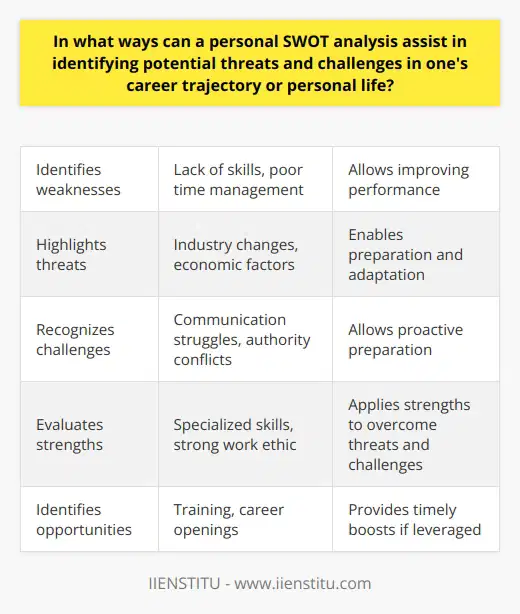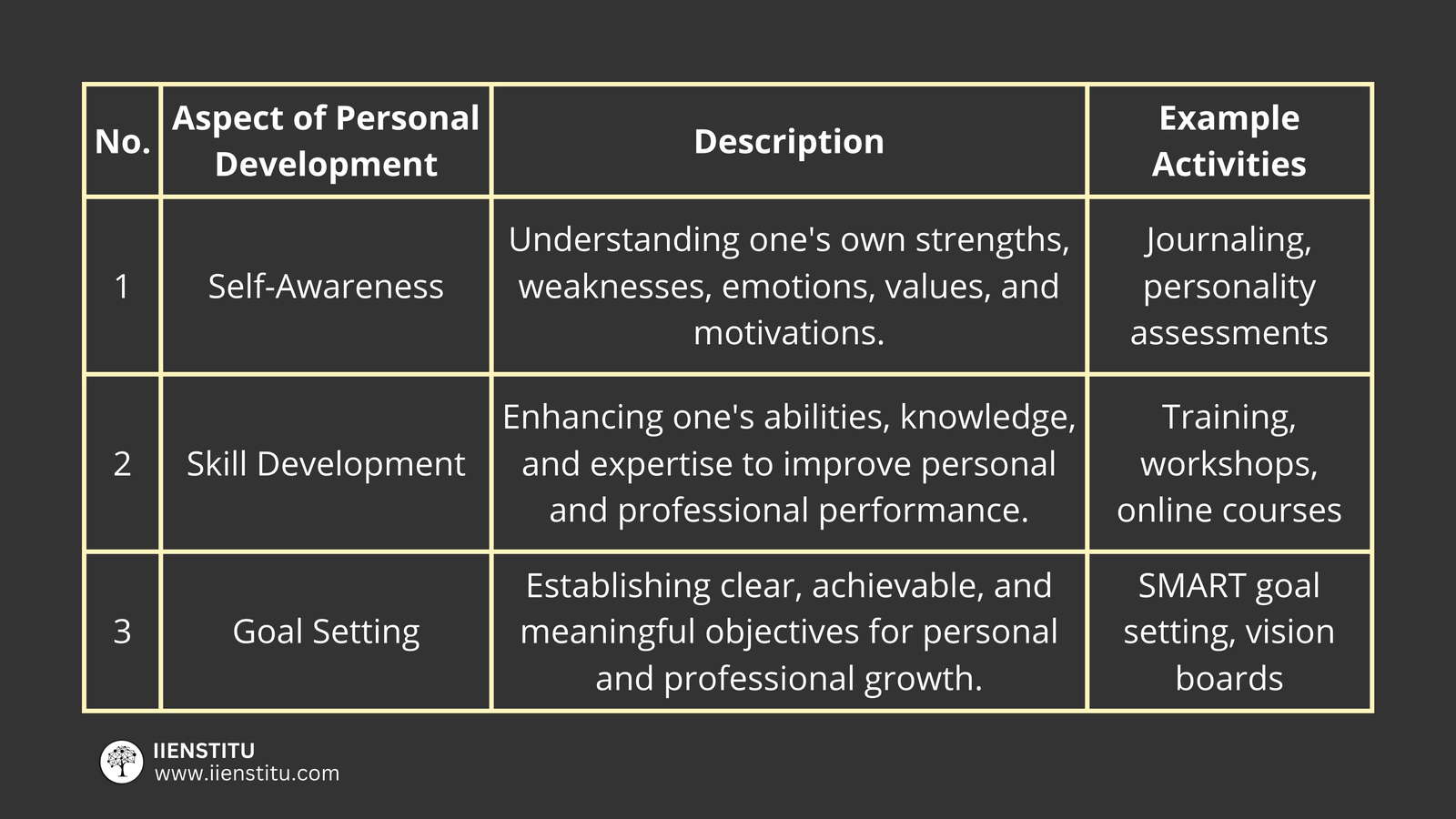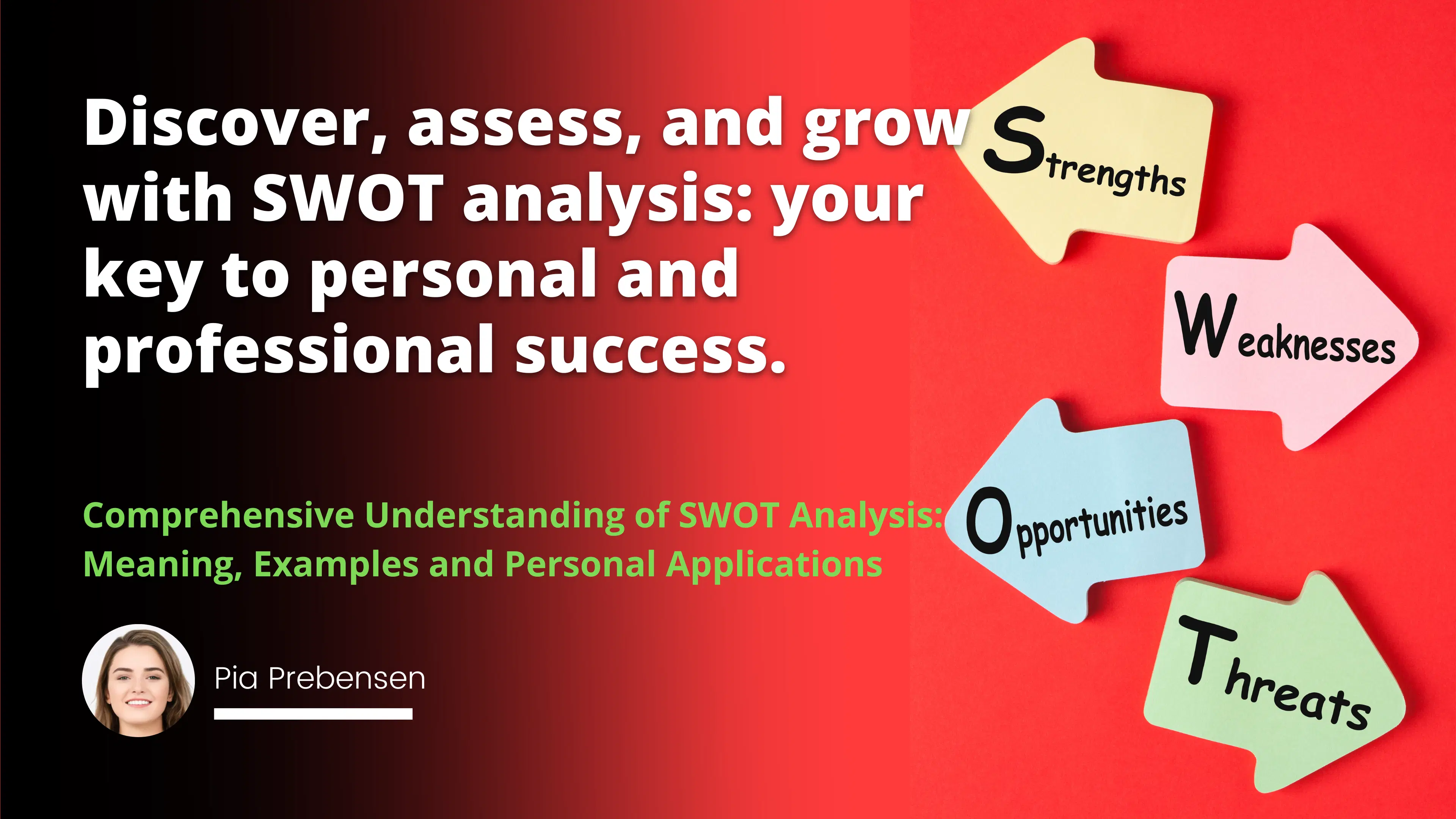
In strategic planning and decision-making, SWOT analysis has emerged as an essential tool for individuals and organizations. With its ability to provide a clear, structured framework for assessing strengths, weaknesses, opportunities, and threats, SWOT analysis offers valuable insights into the internal and external factors that may affect success. In this article, we will explore the meaning of SWOT analysis, provide examples of its application, and discuss how it can be used for personal development.
SWOT Analysis: Meaning and Definition
SWOT is an acronym for Strengths, Weaknesses, Opportunities, and Threats. This strategic planning method is designed to help individuals and organizations identify their internal strengths and weaknesses, as well as external opportunities and threats. By evaluating these four key factors, users can develop a comprehensive understanding of their current position and make informed decisions about their future.
Strengths
Strengths are the internal positive attributes, resources, or capabilities of an individual or organization. These may include unique skills, specialized knowledge, valuable networks, or strong brand recognition. Identifying and leveraging one's strengths can provide a competitive advantage in the marketplace or contribute to personal growth and development.
Weaknesses
Weaknesses are the internal negative aspects or deficiencies that may hinder an individual or organization from achieving its goals. These include needing more resources, outdated technology, poor management, or skill gaps. Recognizing and addressing weaknesses is crucial for improvement and long-term success.
Opportunities
Opportunities are external factors that present the potential for growth, expansion, or other positive outcomes. These include market trends, technological advancements, partnerships, and legislative changes. Individuals and organizations can adapt to their environment and achieve their objectives by capitalizing on these opportunities.
Threats
Threats are external factors that pose challenges or risks to an individual or organization. These may include competitors, economic downturns, regulatory changes, or technological disruptions. Therefore, identifying and mitigating threats is essential for maintaining stability and safeguarding against potential setbacks.
SWOT Analysis Examples
To better understand the application of SWOT analysis, let us consider two examples: one for a business and another for a personal context.
Business SWOT Analysis Example
Imagine a small tech startup that has recently developed a revolutionary software product. Its SWOT analysis could look like the following:
Strengths:
Innovative product with unique features
Highly skilled and motivated team
Strong relationships with industry influencers
Weaknesses:
Limited financial resources
Lack of brand recognition
Insufficient marketing expertise
Opportunities:
Growing demand for software solutions in the target market
Potential strategic partnerships with more prominent tech companies
Government incentives for tech startups
Threats:
Intense competition from established industry players
Rapid technological advancements rendering the product obsolete
Economic downturn affecting the target market
By evaluating these factors, the startup can devise a strategy that capitalizes on its strengths, addresses weaknesses, exploits opportunities, and mitigates threats.
Personal SWOT Analysis Example
Consider an individual seeking to advance their career in marketing. Their SWOT analysis could look like this:
Strengths:
Strong analytical skills
Excellent communication abilities
Proven track record in successful marketing campaigns
Weaknesses:
Limited experience in digital marketing
Difficulty with time management
Weak professional network
Related Course: Course On Time Management
Related Course: Digital Marketing Free Course
Opportunities:
Online courses and certifications to expand digital marketing skills
Networking events to build connections
Demand for marketing professionals in a growing industry
Threats:
Competition from other job seekers with more experience
Automation and artificial intelligence are replacing specific marketing roles
Economic downturn
Job market saturation in the marketing field
By conducting this personal SWOT analysis, the individual can identify areas for improvement, capitalize on opportunities, and mitigate potential threats to their career progression.
Personal SWOT Analysis: Tips and Applications
A personal SWOT analysis can provide valuable insights into one's strengths, weaknesses, opportunities, and threats. Here are some tips for effectively performing a personal SWOT analysis and applying its results to personal growth and development:
Be honest and objective.
When conducting a SWOT analysis, being honest and objective about your strengths, weaknesses, opportunities, and threats is crucial. Overestimating your strengths or underestimating your weaknesses can lead to ineffective decision-making.
Seek feedback from others.
Obtaining input from friends, family, colleagues, or mentors can provide additional perspectives on your strengths and weaknesses. This can help you gain a more comprehensive understanding of your abilities and areas for improvement.
Prioritize your findings
After identifying your strengths, weaknesses, opportunities, and threats, prioritize them based on their potential impact on your personal growth and development. This will help you focus on the most critical areas and allocate your resources effectively.
Develop actionable plans
Translate the results of your SWOT analysis into actionable plans for improvement. For example, if one of your weaknesses is needing more experience in a particular skill, consider enrolling in a course or seeking opportunities to gain that experience.
Monitor progress and reassess
Regularly monitor your progress in addressing your weaknesses and capitalizing on your opportunities. Periodically reassess your SWOT analysis to account for changes in your circumstances, skills, and goals.
Conclusion
SWOT analysis is a powerful tool for assessing one's current position and making informed decisions about the future. By understanding the meaning and application of SWOT analysis, individuals and organizations can gain valuable insights into their strengths, weaknesses, opportunities, and threats. Moreover, by conducting a personal SWOT analysis and applying its findings to personal growth and development, individuals can succeed tremendously in their careers and personal lives.
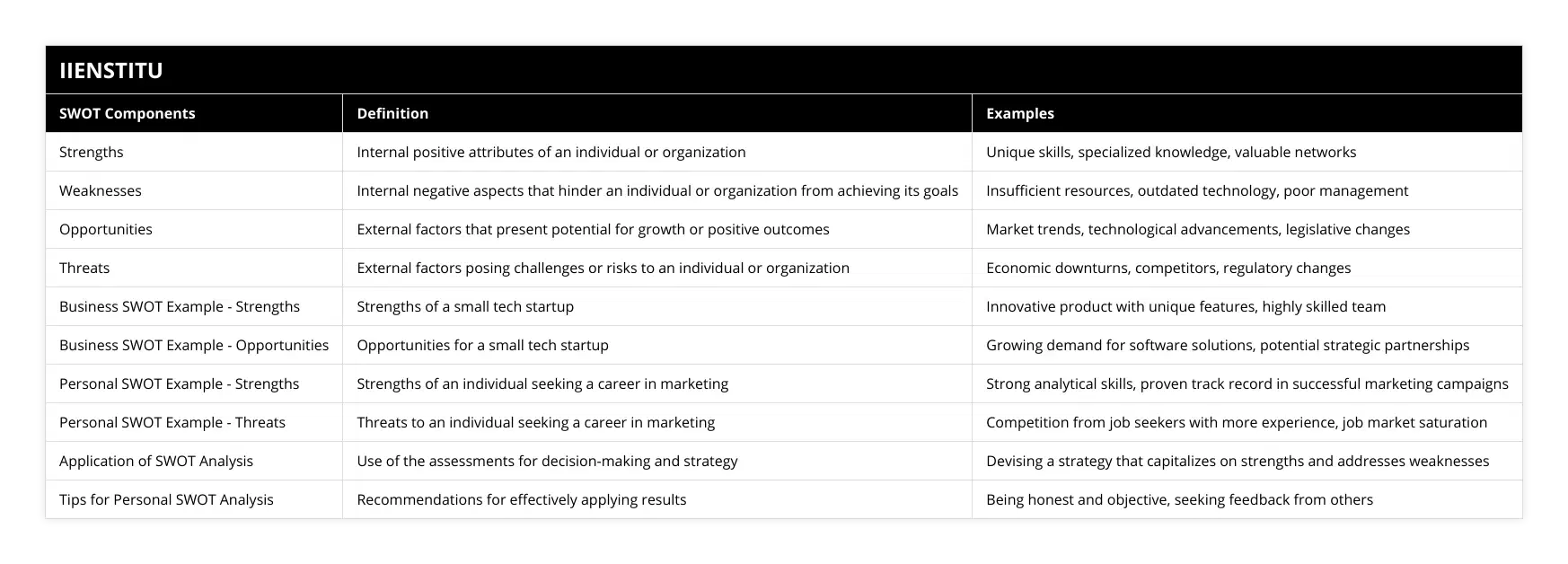
Frequently Asked Questions
What does SWOT stand for?
SWOT stands for Strengths, Weaknesses, Opportunities, and Threats. It is a strategic planning tool used to analyze and evaluate these four key factors for individuals and organizations.
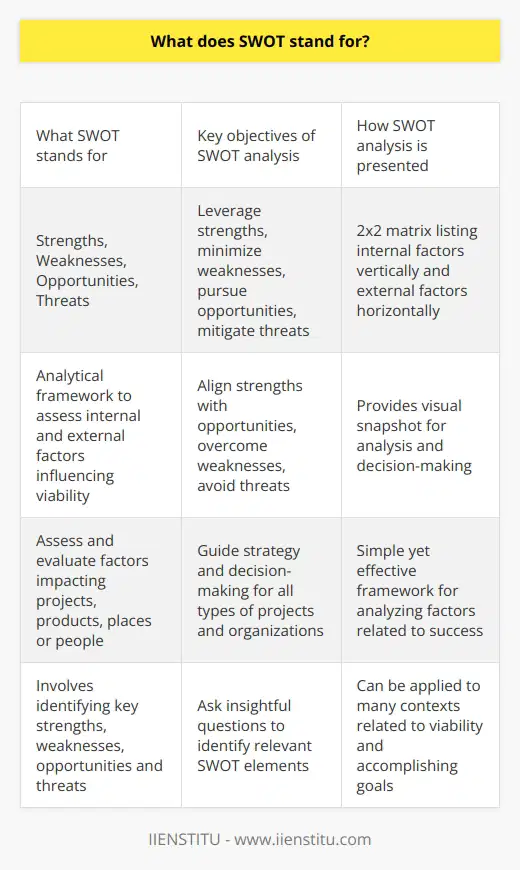
How can I apply SWOT analysis to personal development?
To apply SWOT analysis to personal development, conduct an honest and objective assessment of your strengths, weaknesses, opportunities, and threats. Use this information to create actionable plans for improvement, capitalize on opportunities, and mitigate potential threats.
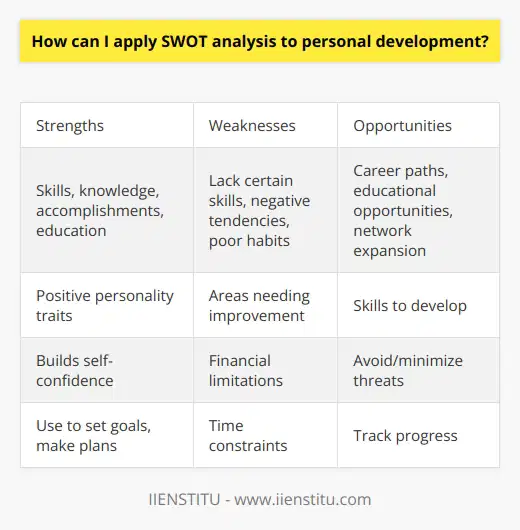
How often should I perform a SWOT analysis?
There is no fixed frequency for conducting a SWOT analysis, but it is generally beneficial to reassess your SWOT analysis periodically or when significant changes occur in your personal or professional life. Regular reassessment helps ensure that your plans and strategies remain relevant and effective.
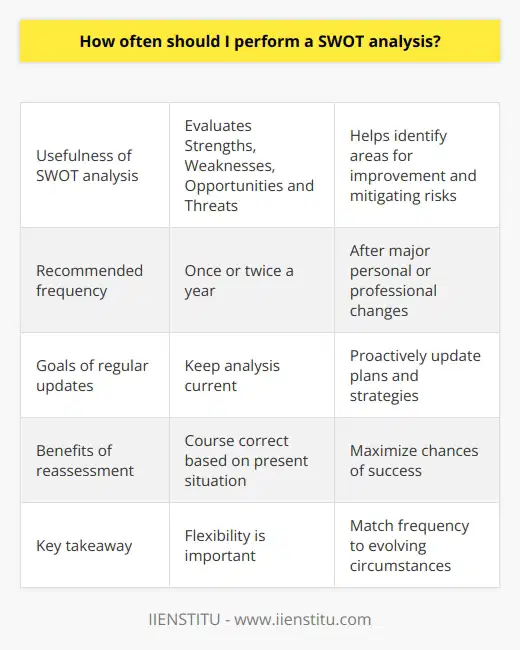
What is the significance of conducting a personal SWOT analysis for individual growth and development?
The Significance of Personal SWOT Analysis
A personal SWOT (Strengths, Weaknesses, Opportunities and Threats) analysis is an instrumental tool for individual growth and development. It provides a clear and precise understanding of one's abilities and limitations. By identifying strengths, people can harness them to achieve personal and professional goals.
Unveiling Weaknesses and Strengths
Equally, recognizing weaknesses creates room for improvement. It provides a roadmap for self-improvement by pinpointing areas that need further development. Undertaking such an analysis helps people understand what they need to work on to grow professionally and personally.
Leveraging Opportunities for Growth
Furthermore, the Opportunities aspect of a personal SWOT analysis actively supports personal development. It aids in identifying potential opportunities for growth, improvement, and advancement. Individuals can strategize on how to optimally utilize these opportunities to boost their development.
Addressing Personal Threats
Lastly, understanding threats helps individuals mitigate potential impediments to their growth and development. Anticipating potential obstacles equips individuals with tactics to effectively counter these threats, thus enabling a smoother path towards their objectives.
In essence, conducting a personal SWOT analysis significantly enhances self-awareness. By offering a comprehensive assessment for individuals, it aids in setting realistic goals based on identified strengths, weaknesses, opportunities, and threats. This process ultimately supports continuous learning, growth, and personal development through a clear understanding of one's capabilities and potentials. This personal introspection is vital for personal and professional evolution. It encourages continuous personal improvement and thus plays a crucial role in individual growth and development.
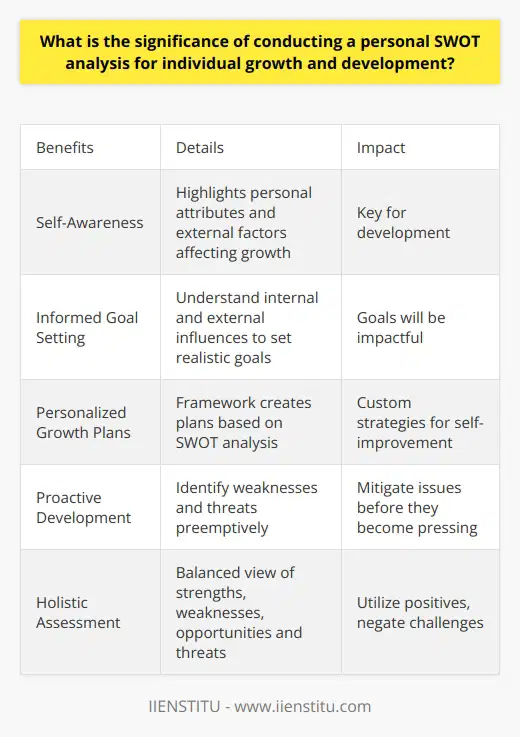
How can the use of SWOT analysis in personal life contribute to better decision-making and goal achievement?
Understanding Strengths
Deploying SWOT analysis in personal life assists in recognizing individual strengths. Understanding these strengths helps individuals in mapping out the best life paths. Essentially, by leveraging personal strengths, individuals can make more informed decisions about their personal and career journeys.
Identifying Weaknesses
Simultaneously, SWOT analysis helps in identifying personal weaknesses. It paves the way for self-improvement, thereby refining individual's decision-making skills. Recognizing personal weaknesses allows for conscious efforts to mitigate their negative impacts or overcome them altogether.
Evaluating Opportunities
Furthermore, SWOT analysis aids in identifying opportunities. These could range from career advancement to self-improvement openings. By being aware of such opportunities, individuals are able to make strategic decisions that will yield the most beneficial outcomes. Moreover, such identification can often lead to greater motivation and self-efficacy in achieving goals.
Considering Threats
Finally, employing SWOT analysis involves considering potential threats. Threats can hinder individuals from reaching their goals. Awareness of potential obstacles and planning ahead to counteract these challenges strengthens decision-making abilities and goal achievement. It further aids in proactive planning and strategic thinking.
Conclusion
In conclusion, using SWOT analysis in personal life contributes significantly to better decision-making and goal accomplishment. By understanding strengths, recognizing weaknesses, evaluating opportunities and considering threats, individuals are able to strategize effectively. This provides a robust mechanism for making calculated decisions that foster goal achievement. Thus, SWOT analysis evidently facilitates a more strategic and effective approach to personal life management.
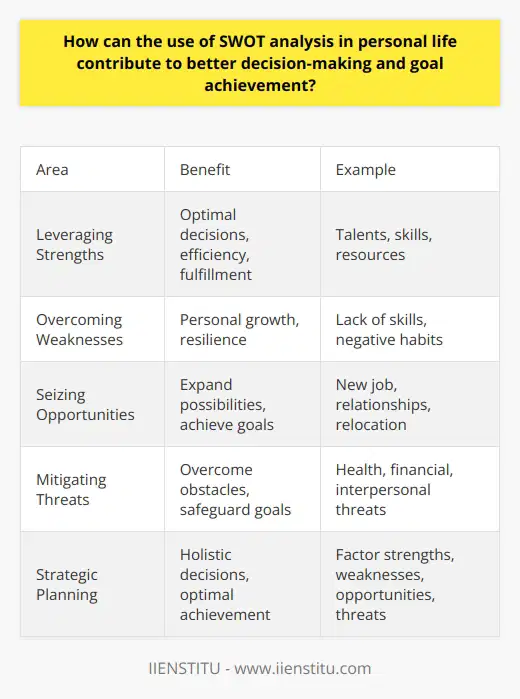
In what ways can a personal SWOT analysis assist in identifying potential threats and challenges in one's career trajectory or personal life?
Assessing Personal Strengths and Weaknesses
A personal SWOT analysis can assist in identifying potential threats and challenges in one's career or personal life by illuminating areas of weakness. This comprehensive personal assessment aids in the identification of weak spots which, if not addressed, could hinder personal and professional development.
Optimizing Opportunities
Concurrently, a SWOT analysis provides a structured way to identify opportunities. This can help an individual recognize beneficial circumstances in their environment, which could provide a strategic advantage in their career or personal life. Exploiting these opportunities can lead to dramatic improvements in outcomes.
Identifying Threats
An equally important aspect is that a personal SWOT analysis aids in recognizing external threats. Being aware of potential issues in your environment that could damage your progress is crucial in preventing stagnation or regression. With this knowledge, individuals can develop contingency plans that allow them to mitigate their impact.
Overcoming Challenges
Lastly, analyzing one’s strengths provides insights into potential challenges. Recognizing these enables the person to use their resources to confront these challenges effectively. Doing so fosters resilience and fuels further personal and career growth.
In conclusion, a personal SWOT analysis primarily facilitates the identification of one's internal strengths and weaknesses, as well as external opportunities and threats. This comprehensive understanding paves the way for strategic planning, problem-solving, and decision-making processes, enhancing the individual's capacity to navigate potential threats and challenges in both their career progression and personal life.
